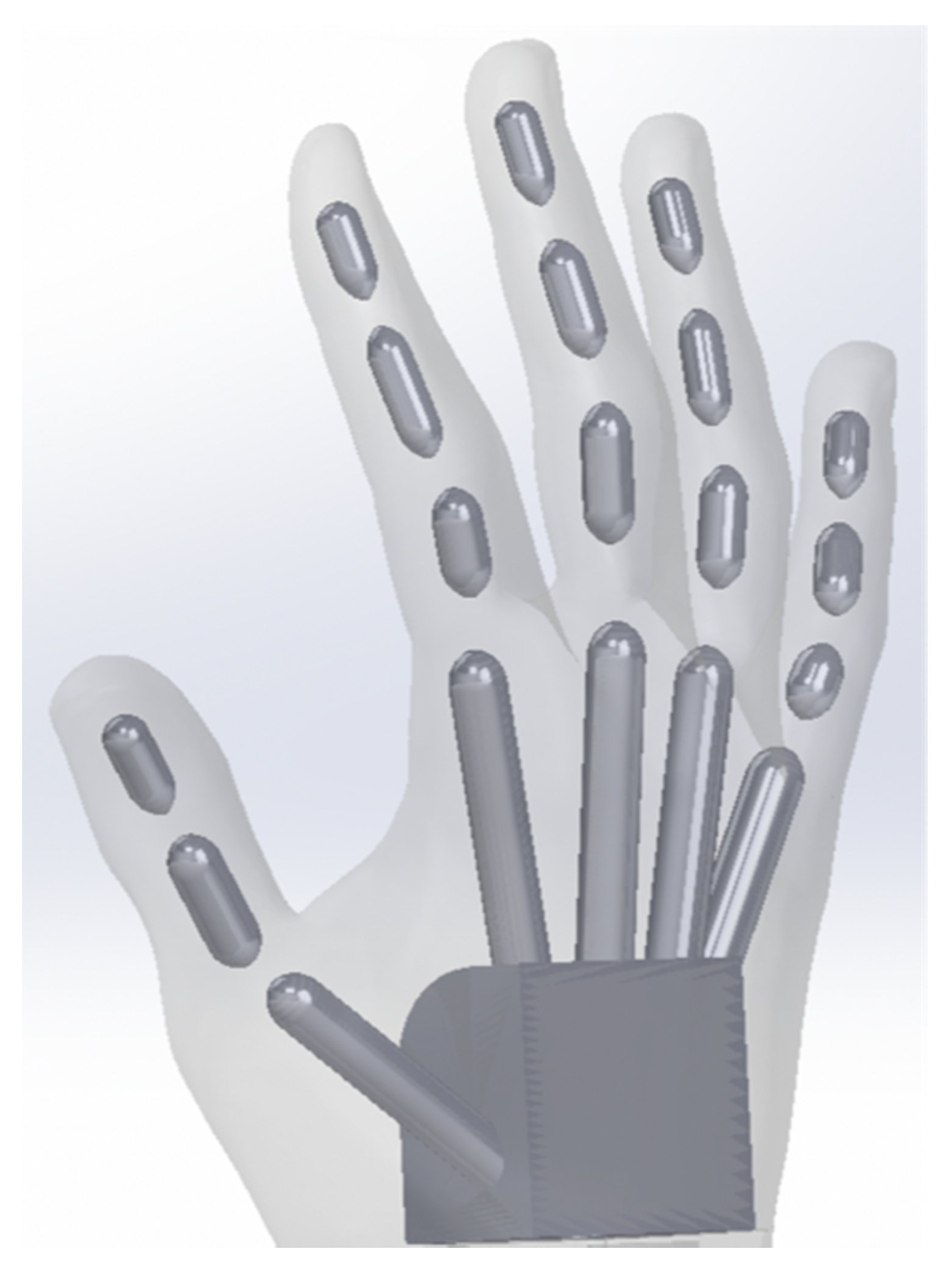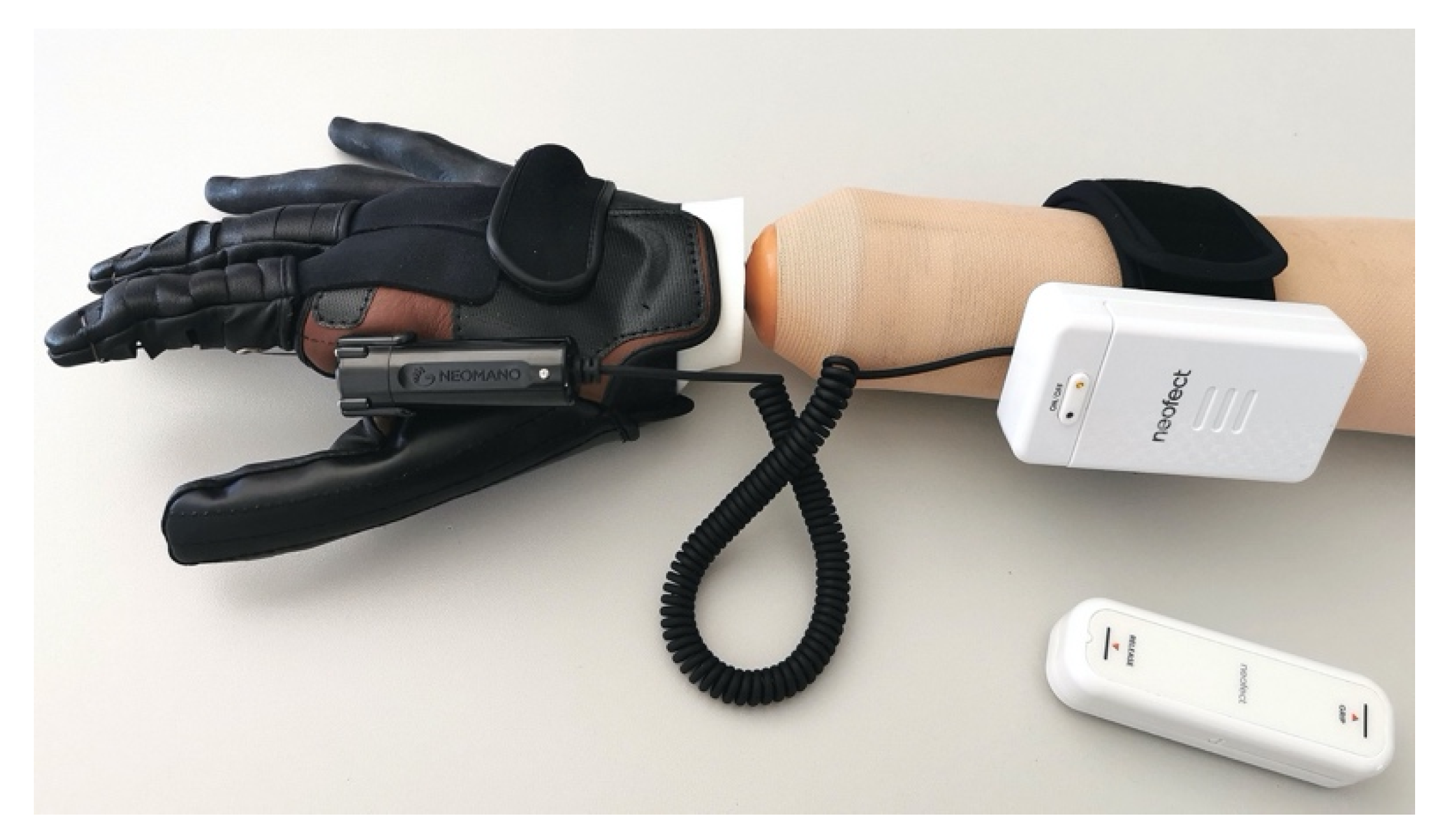3D Multi-Material Printing of an Anthropomorphic, Personalized Replacement Hand for Use in Neuroprosthetics Using 3D Scanning and Computer-Aided Design: First Proof-of-Technical-Concept Study
Abstract
:1. Introduction
2. Results
2.1. Selection of the Material for the Replacement Hand
2.2. Functionality Tests of the Replacement Hand
3. Discussion
4. Materials and Methods
Supplementary Materials
Author Contributions
Funding
Conflicts of Interest
Appendix A


References
- Bouton, C.E.; Shaikhouni, A.; Annetta, N.V.; Bockbrader, M.A.; Friedenberg, D.A.; Nielson, D.M.; Sharma, G.; Sederberg, P.B.; Glenn, B.C.; Mysiw, W.J.; et al. Restoring cortical control of functional movement in a human with quadriplegia. Nature 2016, 533, 247–250. [Google Scholar] [CrossRef] [PubMed]
- Soekadar, S.R.; Witkowski, M.; Gómez, C.; Opisso, E.; Medina, J.; Cortese, M.; Cempini, M.; Carrozza, M.C.; Cohen, L.G.; Birbaumer, N.; et al. Hybrid EEG/EOG-based brain/neural hand exoskeleton restores fully independent daily living activities after quadriplegia. Sci. Robot. 2016, 1. [Google Scholar] [CrossRef] [PubMed] [Green Version]
- McMullen, D.P.; Hotson, G.; Katyal, K.D.; Wester, B.A.; Fifer, M.S.; McGee, T.G.; Harris, A.; Johannes, M.S.; Vogelstein, R.J.; Ravitz, A.D.; et al. Demonstration of a semi-autonomous hybrid brain-machine interface using human intracranial EEG, eye tracking, and computer vision to control a robotic upper limb prosthetic. IEEE Trans. Neural Syst. Rehabil. Eng. 2014, 22, 784–796. [Google Scholar] [CrossRef] [Green Version]
- Otte, A. Smart Neuroprosthetics Becoming Smarter, but Not for Everyone? EClinicalMedicine 2018, 2–3, 11–12. [Google Scholar] [CrossRef]
- Egermann, M.; Kasten, P.; Thomsen, M. Myoelectric hand prostheses in very young children. Int. Orthop. 2009, 33, 1101–1105. [Google Scholar] [CrossRef] [Green Version]
- Otte, A. Invasive versus Non-Invasive Neuroprosthetics of the Upper Limb: Which Way to Go? Prosthesis 2020, 2, 237–239. [Google Scholar] [CrossRef]
- Chadwell, A.; Kenney, L.; Howard, D.; Ssekitoleko, R.T.; Nakandi, B.T.; Head, J. Evaluating Reachable Workspace and User Control over Prehensor Aperture for a Body-Powered Prosthesis. IEEE Trans. Neural Syst. Rehabil. Eng. 2020, 28, 2005–2014. [Google Scholar] [CrossRef] [PubMed]
- Koprnicky, J.; Najman, P.; Safka, J. 3D printed bionic prosthetic hands. In Proceedings of the IEEE International Workshop of Electronics, Control, Measurement, Signals and Their Application to Mechatronics, ECMSM, Donostia, San Sebastian, Spain, 24–26 May 2017. [Google Scholar] [CrossRef]
- Otte, A. 3D Computer-Aided Design Reconstructions and 3D Multi-Material Polymer Replica Printings of the First “Iron Hand” of Franconian Knight Gottfried (Götz) von Berlichingen (1480–1562): An Overview. Prosthesis 2020, 2, 304–312. [Google Scholar] [CrossRef]
- Leow, M.E.L.; Ow, R.K.K.; Lee, M.H.; Huak, C.Y.; Pho, R.W.H. Assessment of colour differences in silicone hand and digit prostheses: Perceptible and acceptable thresholds for fair and dark skin shades. Prosthet. Orthot. Int. 2006, 30, 5–16. [Google Scholar] [CrossRef] [PubMed]
- Hazubski, S.; Hoppe, H.; Otte, A. Non-contact visual control of personalized hand prostheses/exoskeletons by tracking using augmented reality glasses. 3D Print. Med. 2020, 6, 20–22. [Google Scholar] [CrossRef] [PubMed]
- Hazubski, S.; Hoppe, H.; Otte, A. Electrode-free visual prosthesis/exoskeleton control using augmented reality glasses in a first proof-of-technical-concept study. Sci. Rep. 2020, 10, 1–10. [Google Scholar] [CrossRef] [PubMed]
- Stratasys. Available online: https://www.stratasys.com/de/materials/search/agilus30 (accessed on 21 November 2020).
- Stratasys. Available online: https://www.stratasys.com/de/materials/search/vero (accessed on 21 November 2020).
- Baron, J. 3D-Druck Einer Anthropomorphen Ersatzhand für die Neuroprothetik [3D Printing of an Anthropomorphic Artificial Hand for Neuroprosthetics]. Bachelor’s Thesis, Offenburg University, Offenburg, Germany, 31 August 2020. [Google Scholar]





| Finger | Shore-A-Value | Flexibility and Effort | Tearing | Strength |
|---|---|---|---|---|
| 1 | 30 | Full flexion with minimal force | no | soft, unnatural |
| 2 | 40 | Full flexion with average force | no | soft, unnatural |
| 3 | 50 | Full flexion with average force | no | medium, natural |
| 4 | 60 | Full flexion with above average force | no | rigid, natural |
| 5 | 70 | Full flexion with maximum force | yes | rigid, unnatural |
Publisher’s Note: MDPI stays neutral with regard to jurisdictional claims in published maps and institutional affiliations. |
© 2020 by the authors. Licensee MDPI, Basel, Switzerland. This article is an open access article distributed under the terms and conditions of the Creative Commons Attribution (CC BY) license (http://creativecommons.org/licenses/by/4.0/).
Share and Cite
Baron, J.; Hazubski, S.; Otte, A. 3D Multi-Material Printing of an Anthropomorphic, Personalized Replacement Hand for Use in Neuroprosthetics Using 3D Scanning and Computer-Aided Design: First Proof-of-Technical-Concept Study. Prosthesis 2020, 2, 362-370. https://0-doi-org.brum.beds.ac.uk/10.3390/prosthesis2040034
Baron J, Hazubski S, Otte A. 3D Multi-Material Printing of an Anthropomorphic, Personalized Replacement Hand for Use in Neuroprosthetics Using 3D Scanning and Computer-Aided Design: First Proof-of-Technical-Concept Study. Prosthesis. 2020; 2(4):362-370. https://0-doi-org.brum.beds.ac.uk/10.3390/prosthesis2040034
Chicago/Turabian StyleBaron, Jana, Simon Hazubski, and Andreas Otte. 2020. "3D Multi-Material Printing of an Anthropomorphic, Personalized Replacement Hand for Use in Neuroprosthetics Using 3D Scanning and Computer-Aided Design: First Proof-of-Technical-Concept Study" Prosthesis 2, no. 4: 362-370. https://0-doi-org.brum.beds.ac.uk/10.3390/prosthesis2040034







